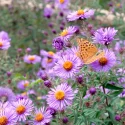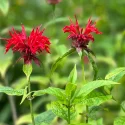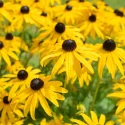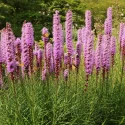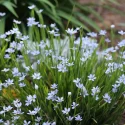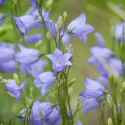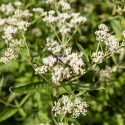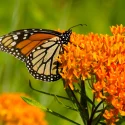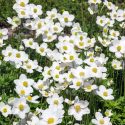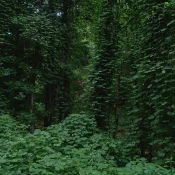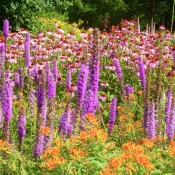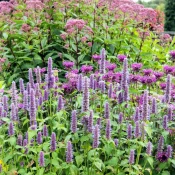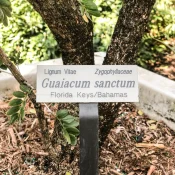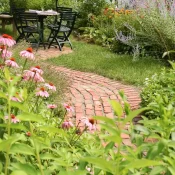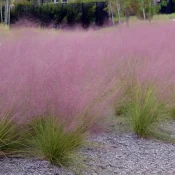Lawns vs. native gardens — What’s easier?
Native gardens are lower maintenance, cheaper, and better for the planet than lawns. Less work, less water, and zero fertilizer—just a thriving, self-sustaining ecosystem.
We did the math—lawns can take 24X more time than a native garden. Want your weekends (and water bill) back? Swap some (or all!) of your lawn for native plants. Scroll to see the real savings.
Lawns vs. Native Garden – Pros + Cons
Stacking up the pros and cons of a lawn versus a native garden makes it easy to see that native gardening is more affordable and saves time compared to grass.
Lawn
Basic needs for a suburban lawn-
Needs water during summer/dry periods
-
Reseeding in spring + fall
-
Weekly mowing
-
Requires weeding (or chemicals)
Native Garden
Basic needs for a native garden-
Thrives with normal rainfall
-
Perennials return every year, no replanting
-
Easy care once rooted
-
Minimal weeding with mulch
Let’s dig deeper into the time, water, and money differences between a native garden and a lawn:
Lawns: the time-suck of our lives
The reality of lawns is that they take hundreds of hours of our lives away. Let’s take a look at the six steps that Scott’s Lawn Care recommends for “The Best Looking Lawn on the Block” (literally copied/pasted from their website):
- Feed 4 times a year
- Mow at the right time and height
- Water the lawn properly
- Use premium grass seed
- Spot-control weeds
- Prevent grubs
This already sounds like a ton of work and time. And Scotts goes on:
“But lawn pros know the truth: that your grass needs to be fertilized several times throughout the year, using the right lawn food for the season and your region. At Scotts, we believe the ideal number of feedings is 4.”
“It’s also important to mow frequently enough that you’re never removing more than 1/3 of the grass blade height at a time.”
Yikes. That sounds like a part-time job!
Let’s take that same list again, but put the hours required beside it for a suburban lawn that’s less than an acre:
- Feed 4 times a year (4 hours apiece x 4 times = 16 hours)
- Mow at the right time and height (22 weeks x 1 hour = 22 hours)
- Water the lawn properly (24 hours a year)
- Use premium grass seed (spreading grass seed = 4 hours x 2 times a year = 8 hours)
- Spot-control weeds (20 hours a year)
- Prevent grubs (10 hours a year)
The results are in: lawns are SO MUCH WORK.
Let’s see how DIY native gardening stacks up.
Native gardening saves time
There is a strange misconception that gardening requires hours and hours of weeding and care. Native plants have grown for thousands of years with no human help at all. Native gardening requires very little time (unless you’d like to spend it!) It’s the non-native plants that need special care and take hours of time. (We’ve broken down the hours needed for non-native versus native gardening in a separate post.)
Here are some ways that native gardening saves time:
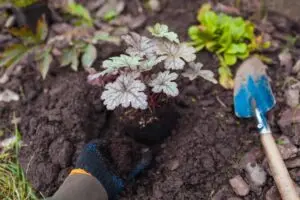
Native perennials come back year after year
Plant a native perennial once, and enjoy them for years and years—even decades! Spend an hour (or honestly, it can take just 15 minutes) planting a single native plant and enjoy it for years. Explore native perennials in our native plant library
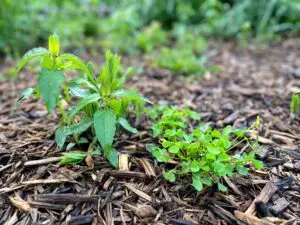
Mulch drastically cuts back on weeding
Weeding can take the time it takes to finish a cup of coffee if you put mulch around native plants. Weeds come whenever their seeds come in contact with the sun. Cover weed seeds with mulch or gravel before they have a chance to grow for a weed-free garden—it’s really that easy!
How much time does a native garden take?
Lorraine Johnson shares her experience with native gardening in her fantastic book, “100 Easy to Grow Native Plants.” She writes:
“I’ve always known that my [native] garden was a low-maintenance project… but was shocked to discover just how low-maintenance it is. The grand total of time I spent on garden maintenance from the spring through to autumn: 3 hours and 15 minutes. Total.
That includes weeding, watering, pruning, dead-heading, digging, dividing, transplanting… everything. When I say ‘easy-to-grow,’ I mean it quite literally.”
WOW.
3.25 HOURS A YEAR for native garden maintenance?! Yes, please! Let’s see how it stacks up to lawn care needs:
We will gladly take NINETY-SIX HOURS of our lives back with a native garden. We can now use those hours to do whatever the hell we want as we admire gorgeous flowers alongside butterflies and hummingbirds.
Now, let’s see about lawns vs. native plants when it comes to cost.
Lawns vs. Native Gardens: Which Saves More Money?
Let’s quickly see how the costs of having a lawn versus a native garden stack up.
Lawn costs
We’ll stick with pricing based on Scotts’ six recommendations:
- Feed 4 times a year (Scotts Lawn Food $101.99 x 4 times = $407.96)
- Mow at the right time and height *see below
- Water the lawn properly (According to Today’s Homeowner, summer water bills for lawns run between $50-156 a month = $200-624 a year)
- Use premium grass seed (Scotts Turf Builder $76.49 x 2 times = $152.98)
- Spot-control weeds (Scotts Spot Control $17.99 x 3 = $53.97)
- Prevent grubs (Scotts GrubX $59.49)
* And we haven’t included landscaping costs, if you are not mowing yourself!
Native plant costs
The most expensive part of native gardens is (potentially) buying plants. Let’s estimate the cost of putting in a sunny native garden somewhere in the Midwest that runs beside a 25′ long driveway:
- We can easily find free Bee Balm plants via our local gardening Facebook group ($0)
- Same with Obedient Plants—our neighbor gives us some from her garden in the spring ($0)
- We can get 1/2 ounce of Coneflower seeds from Johnny’s Seeds ($7.70)
- We buy three packets of Milkweed seeds from American Meadows ($4.95 x 3 = $14.85)
- We splurge and buy four Rattlesnake Masters from our local nursery ($18.99 x 4 = $75.96)
- We get four bags of hardwood mulch to keep the weeds down from our local nursery ($4.47 x 4 = $17.88)
- We also bought gardening gloves and a trowel at Target ($19.55)
Because all these are perennial plants, they come back year after year. So the only thing we need to buy after the first year is mulch to keep the weeds down.
Water Use: Lawns vs. Native Gardens—Which Wins?
When it comes to watering a lawn, we can let Scott’s lawncare speak for itself:
“In the spring you might only need to water once per week, while in the summer you might need to water 3 times per week.”
Watering a lawn THREE TIMES A WEEK? I’m sorry—did I read that correctly? Who has that kind of time—or extra money set aside for the water bill?
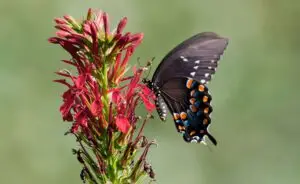
Once a native plant is established, all it needs is rain
Native plants have thrived in their home areas for thousands of years with just rain. The forests, glades, and natural meadows where native plants come from thrive happily with whatever the weather brings. Native plants in your garden will do the same.
Let’s see how the water needs stack up for lawns and native gardening:
Free will always beat a water bill. Thanks to native gardening, our summer water bills will not cause a sudden shock.
In conclusion: native gardens take much less time, money, and water than lawns
It’s shocking to see the amount of time, money (and water!) lawns take compared to native gardens. Lawns have mistakenly been marketed as “easy” compared to gardens, but in reality, lawns take 2400% MORE TIME than a native garden. Get your time, money, and water back and replace some (or all!) of your lawn with a native garden.
Feeling scared to dig up lawn and replace with native gardens?
It can feel like a huge step to dig up lawn and replace it with a native garden. What if it dies? What if you don’t like it? What if you simply change your mind?
The truth is that it is very easy to replant lawn with seed or sod if you feel you made a mistake. So don’t worry about digging up your lawn—go for it! Read our article on quick garden fixes to build up your confidence. Happy native planting!
